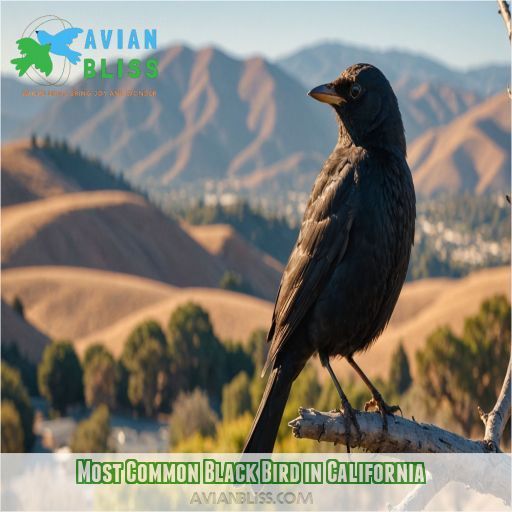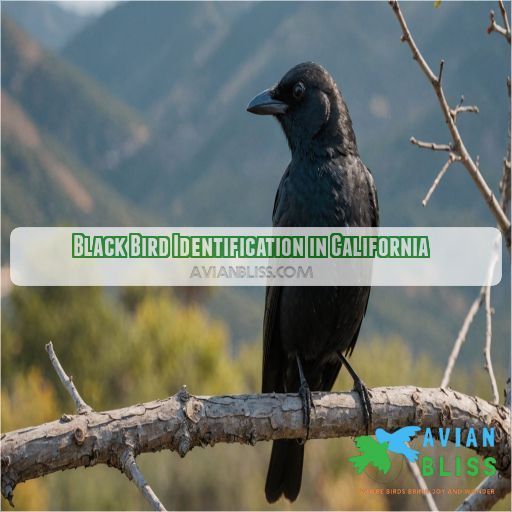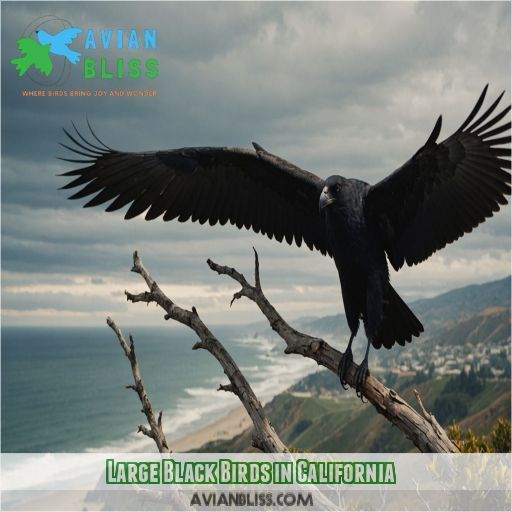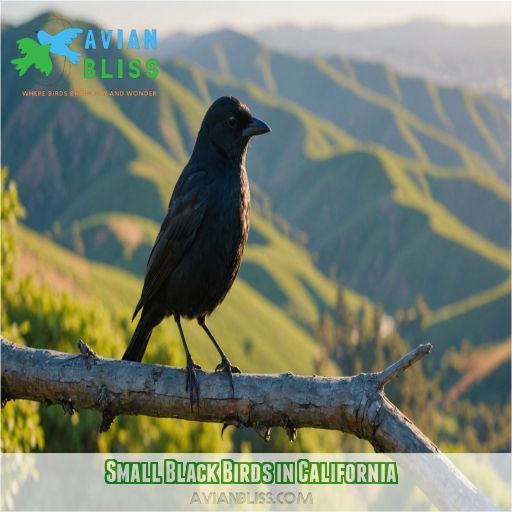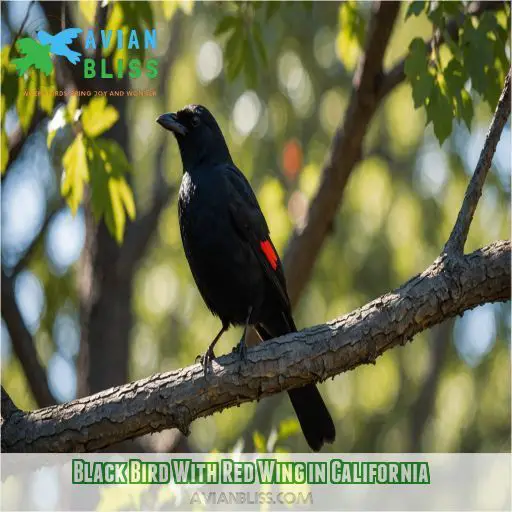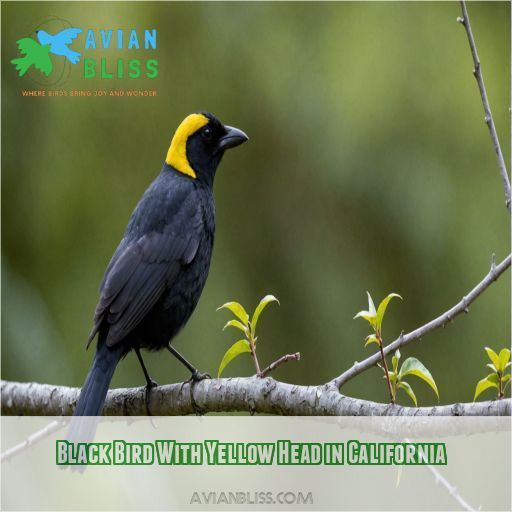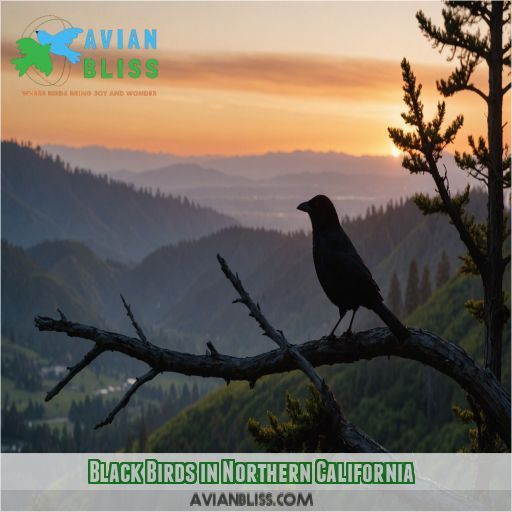This site is supported by our readers. We may earn a commission, at no cost to you, if you purchase through links.
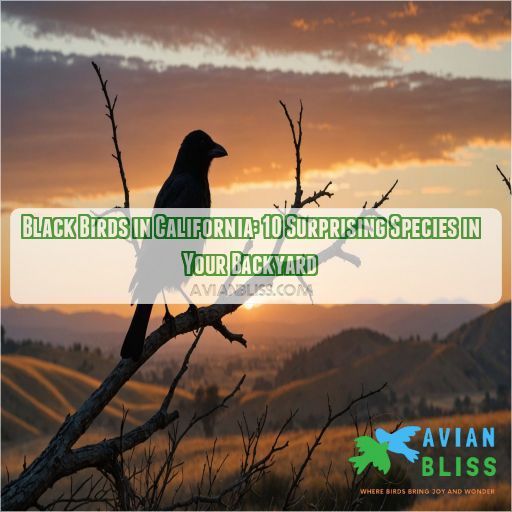
Table Of Contents
- Key Takeaways
- Black Birds in California
- Most Common Black Bird in California
- Black Birds in California Backyards
- Black Bird Identification in California
- Large Black Birds in California
- Small Black Birds in California
- Black Bird With Red Wing in California
- Black Bird With Yellow Head in California
- Black Birds in Northern California
- Black Birds in Southern California
- Frequently Asked Questions (FAQs)
- What is the black bird in California?
- What is a black bird other than a crow?
- Why are black birds in my backyard?
- Is a black bird a raven or crow?
- What is the conservation status of black birds in California?
- How do black birds in California adapt to climate change?
- What are the primary predators of black birds in California?
- Can black birds in California be considered an invasive species?
- How do black birds in California impact local agriculture?
- Conclusion
Key Takeaways
- You’ll be amazed at the diversity of black birds in California – from the common Red-winged Blackbird to the rare Tricolored Blackbird – and you can spot them in your own backyard by paying attention to size, beak shape, and plumage.
- When identifying black birds in California, don’t just look for color – listen for distinctive calls, like the Red-winged Blackbird‘s gurgling "konk-la-ree" song, and observe beak shape variations, like the Tricolored Blackbird’s sharp, pointed beak.
- Black birds in California are adapting to climate change by shifting their breeding colonies to new areas, such as agricultural lands, and you can help them out by creating a black bird-friendly habitat in your backyard with native plants, bird feeders, and fresh water.
- While some black birds, like the European Starling, are considered invasive species, California’s native black birds, like the Tricolored Blackbird, are actually struggling to survive due to habitat loss and agricultural dependence – so, let’s give these sleek creatures a helping hand and some bird love!
Black Birds in California
You’re probably no stranger to the sight of black birds flitting around your California backyard, but have you ever stopped to think about the amazing diversity of species that call the Golden State home? From the common Red-winged Blackbird to the rare Tricolored Blackbird, California is a haven for these mysterious and fascinating birds.
Common Black Bird Species in California
You’re likely to spot several common black bird species in California, including the Red-winged Blackbird and Tricolored Blackbird. The Red-winged Blackbird, with its distinctive red and yellow patches, is a frequent visitor to backyards and wetlands. Meanwhile, the Tricolored Blackbird, with its striking red shoulder patch, can be found in coastal scrub and grasslands, particularly during breeding season.
Identifying Black Birds in California
As you explore California’s great outdoors, identifying black birds can be a fun challenge. Start by looking for distinctive markings, like the Tricolored Blackbird’s red shoulder patch or the Red-winged Blackbird’s bright red and yellow shoulders. Pay attention to beak shape, size, and plumage variations. Listen for unique calls, like the Red-winged Blackbird’s gurgling "oak-a-lee" song.
Unique Characteristics of California Black Birds
You’re about to uncover the unique characteristics of California black birds! These avian wonders boast beak shape variations, iridescent feather colors, and distinctive song patterns that set them apart. Observe the Tricolored Blackbird‘s courtship display rituals or the Red-winged Blackbird‘s territorial songs. Understanding these traits will deepen your connection with these amazing creatures and inspire bird conservation efforts.
Most Common Black Bird in California
You’re probably familiar with the sight of black birds flitting around your California backyard, but have you ever wondered which species is the most common? In this section, we’ll explore the Red-winged Blackbird, a medium-sized songbird with a distinctive red and yellow shoulder patch, and discover why it’s the most common black bird in California.
Red-winged Blackbird Description and Range
As you explore California’s wetlands, you’re likely to spot the Red-winged Blackbird, with its sleek black plumage and distinctive red and yellow wing patches. Found throughout North America, this bird thrives in wetlands, open fields, and agricultural areas, singing its characteristic "oak-a-lee" tune. Its adaptability has helped it flourish, despite habitat loss and population decline in some areas.
European Starling as an Invasive Species
The European starling, an invasive species, is one of the most common black birds in California. But how did they get there?
- The European starling was introduced to North America in 1890 by Shakespeare enthusiasts who wanted to see all the birds mentioned in his works represented on the continent.
- Since then, they’ve spread across the country and are now found in every US state, as well as parts of Central and South America.
- They were also intentionally introduced to South Africa, Australia, New Zealand, and the Pacific Islands.
- European starlings have a significant impact on native bird populations, agricultural crops, and public health.
- They’re aggressive competitors for food and nesting sites, often outcompeting native bird species and causing their populations to decline.
- Starlings eat cattle rations and destroy fruit and grain crops, causing financial losses for farmers.
- They can also carry diseases that affect humans, livestock, and other birds.
- Their large flocks can create noise and sanitation issues, especially near airports and in urban settings.
- Natural predators like hawks, falcons, and owls can help control starling populations.
- Modifying habitats to make them less favorable for starlings, such as removing nesting sites and reducing food sources, can also deter them.
- Exclusion techniques, such as netting and bird spikes, can prevent starlings from accessing certain areas.
- Chemical control methods, such as avicides and roost dispersal chemicals, can be used but may also impact non-target species.
The European starling is an invasive and highly adaptable species that has had a detrimental effect on native bird populations and ecosystems. Various methods are used to control their populations, but their impact remains a concern.
Brown-headed Cowbird as a Nesting Bird
As you explore California’s bird scene, you’ll encounter the Brown-headed Cowbird, a nesting bird with a unique approach. Instead of building its own nest, it practices brood parasitism, laying eggs in other species’ nests. This behavior raises conservation concerns, as it can have a big impact on host populations. Keep an eye out for these sneaky birds in your backyard!
Black Birds in California Backyards
You can easily attract black birds to your California backyard by offering their favorite foods, such as sunflower seeds and suet, and providing a source of fresh water. By creating a black bird-friendly habitat, you’ll be able to enjoy the fascinating behaviors of these beautiful birds up close and personal .
Attracting Black Birds With Food and Water
Attracting black birds to your California backyard is easier than you think! Frequently fill bird feeders with their favorite seeds, like sunflower and Nyjer. Provide water sources, such as bird baths or shallow dishes, and change the water often. By doing so, you’ll be well on your way to creating a haven for these beautiful birds.
Creating a Black Bird-Friendly Habitat
Let’s create a haven for those beautiful black birds in your California backyard! Start by incorporating native plants that provide berries, seeds, and insects for them to feast on. Add water sources, like shallow birdbaths or ponds, and install nest boxes specifically designed for black birds. Don’t forget to use safe pesticides and implement predator control to keep them safe.
Common Black Bird Species in California Backyards
Now that you’ve created a black bird-friendly habitat, you’re probably wondering which species will visit your backyard. You’re in luck! California is home to many fascinating black bird species. Here are some common ones you might spot:
- Red-winged Blackbirds, known for their distinctive calls and territorial behavior
- European Starlings, with their iridescent feathers and mimicry skills
- Tricolored Blackbirds, a California native with a distinctive red shoulder patch
- Brown-headed Cowbirds, infamous for their brood parasitism
- American Crows, intelligent and social birds with a distinctive call
Black Bird Identification in California
You’re ready to sharpen your bird-watching skills and identify those mysterious black birds in your California backyard. In this section, you’ll learn how to tell apart the Tricolored Blackbird from the Red-winged Blackbird, distinguish between Ravens and Crows, and maybe even catch a glimpse of the rare Yellow-headed Blackbird.
Distinguishing Tricolored Blackbird From Red-winged Blackbird
Now that you’ve learned how to attract black birds to your backyard, let’s talk about identifying them. Distinguishing Tricolored Blackbirds from Red-winged Blackbirds can be tricky, but here are some key differences:
| Tricolored Blackbird | Red-winged Blackbird | |
|---|---|---|
| Red Patch | White bar below red patch | No white bar |
| Habitat | Coastal areas, Central Valley | Wetlands, fields |
| Call | Sharp, nasal "kip-kip-kip" | Gurgling "oak-a-lee" |
| Mating | Monogamous | Polygynous |
| Conservation | Listed as Endangered | Not listed |
Identifying Ravens and Crows in California
As you explore California’s backyard bird scene, you might wonder: "Raven or Crow?" Here’s the lowdown: Ravens are larger, with thicker beaks and a wedge-shaped tail, while Crows are smaller, with a fan-shaped tail. Listen for Ravens’ deeper, raspy calls and Crows’ higher-pitched caws. Habitat-wise, Ravens prefer mountains and forests, while Crows thrive in urban areas and woodlands.
Yellow-headed Blackbird as a Rare Species
As you venture into California’s wetlands, you might be lucky enough to spot a Yellow-headed Blackbird, a rare species in the state. With its distinctive yellow head and black body, it’s a sight to behold.
- Habitat loss and fragmentation have contributed to its decline
- Breeding behavior is often disrupted by human activity
- Conservation efforts are underway to protect its range and population
Large Black Birds in California
You’re probably familiar with the sleek silhouettes of large black birds in California.
Have you ever stopped to think about which species you’re actually seeing?
In this section, we’ll explore three of the most common large black birds in California: the American Crow, the Common Raven, and the Turkey Vulture (which, spoiler alert, isn’t actually a black bird at all!).
American Crow as a Large Black Bird
Meet the American Crow, a large black bird that’s as clever as it’s common in California. With a diet that includes seeds, nuts, and insects, these birds are adaptable and intelligent. They thrive in various habitats, from woodlands to backyards. Their complex social behavior and innovative problem-solving skills make them fascinating to watch and study.
Common Raven as an Intelligent Bird
Now that we’ve talked about the American Crow, let’s talk about its brainy cousin, the Common Raven. You might be surprised to learn that Ravens are considered one of the most intelligent bird species. Here are 4 fascinating facts about Raven intelligence:
- They use tools to solve problems and gather food .
- They exhibit complex social behavior and have been observed playing with each other .
- They’re able to solve puzzles and plan for the future .
- They’ve even been known to outsmart humans in some cases !
Turkey Vulture as a Misidentified Black Bird
You’re birdwatching in California, and you spot a large, dark bird soaring overhead. You might think it’s a black bird, but wait – it could be a Turkey Vulture! These birds are often misidentified due to their dark plumage, but they’ve some distinct features.
| Turkey Vulture | Crow |
|---|---|
| Dark brown with a reddish hue | Glossy black |
| Broad, rounded wings | Narrow, pointed wings |
| Feeds on carrion | Omnivorous, eats seeds and insects |
Small Black Birds in California
You’re about to discover the fascinating world of small black birds in California, where species like the Dark-eyed Junco, Downy Woodpecker, and Brown-headed Cowbird will captivate you with their unique characteristics. As you explore your backyard or venture into the wild, keep an eye out for these tiny birds, and get ready to be charmed by their distinct behaviors and traits .
Dark-eyed Junco as a Small Black Bird
As you explore California’s backyard birds, you might stumble upon the Dark-eyed Junco, a small, sleek bird with a distinctive black hood. In winter, their plumage turns a darker gray, and their song varies by region. Found in coniferous forests and woodlands, they’re common visitors to bird feeders, particularly during the colder months.
Downy Woodpecker as a Small Black and White Bird
You might be surprised to spot a Downy Woodpecker, a small black and white bird, in your California backyard! They’re only about 6-7 inches long and weigh around 1 ounce . These tiny woodpeckers inhabit deciduous forests and woodlands , snacking on insects and sap . Their high-pitched calls and acrobatic antics make them a delight to watch .
Brown-headed Cowbird as a Small Black Bird
As you gaze out at your backyard, you might spot a small black bird with a distinctive brown head – the Brown-headed Cowbird. Here are a few fascinating facts about this bird:
- Nest parasitism: Cowbirds are known to lay their eggs in other birds’ nests, a behavior called brood parasitism.
- Omnivorous diet: They munch on insects, seeds, and fruits.
- Unique vocalization: Listen for their distinctive, gurgling call, often described as a series of whistled notes.
Black Bird With Red Wing in California
As you explore the fascinating world of black birds in California, you’re likely to spot a bird with a distinctive red wing.
Is it a Red-winged Blackbird or the rarer Tricolored Blackbird?
Let’s take a closer look at these two species and learn how to tell them apart.
You can impress your friends with your birding skills next time you spot one in your backyard!
Red-winged Blackbird as the Most Common Black Bird
As you step into your backyard, you might catch a glimpse of the Red-winged Blackbird, California’s most common black bird with a distinctive red wing patch.
These medium-sized songbirds thrive in wetlands, open fields, and backyards with bird-friendly habitats.
With a diet of insects, seeds, and grains, they’re frequent visitors to bird feeders, bringing a splash of color and lively songs to your outdoor space.
Tricolored Blackbird as a Rare Species
As you’ve learned about the Red-winged Blackbird, you might be curious about its lesser-known cousin, the Tricolored Blackbird. This California native has a distinctive red shoulder patch with a bright white bar, but its population has drastically declined due to habitat loss. Conservation efforts are underway to protect its nesting habits and boost its dwindling numbers.
Black Bird With Yellow Head in California
As you explore the fascinating world of black birds in California, you might be surprised to discover that some species have a pop of yellow on their heads, adding a bright twist to their sleek black plumage.
You’ll learn about the American Goldfinch and Yellow Warbler, two birds that boast striking yellow features and might just become your new favorite backyard visitors.
American Goldfinch as a Yellow Bird With Black Wings
You might be thinking, "Wait, isn’t this article about black birds?" But hear me out! The American Goldfinch, with its vibrant yellow feathers and sleek black wings, is a stunning bird that’s sure to brighten up your backyard. Here are some fascinating facts about these tiny beauties:
- They love to munch on seeds, particularly sunflower and nyjer .
- You can spot them in open fields, meadows, and backyards with thistle plants .
- They breed in late summer, with males singing their hearts out to attract females .
- They migrate in flocks, following the same route each year .
- Conservation efforts are underway to protect their habitats and reduce pesticide use .
Yellow Warbler as a Yellow Bird With Black Stripe
You’re still on the lookout for that yellow bird with black accents, but now you’re wondering if it’s a Yellow Warbler instead of an American Goldfinch.
Well, let’s get to know this little songster!
Yellow Warblers have a distinctive black stripe through their eye and a bright, cheerful song.
They migrate to California for the winter, enjoying wetlands and insects along the way.
Black Birds in Northern California
You’re about to spot some amazing black birds in Northern California, so get your binoculars ready! From the common Red-winged Blackbird to the rare Tricolored Blackbird, you’ll discover the unique characteristics and habitats of these fascinating species in the region .
Common Black Bird Species in Northern California
Now that we’ve talked about black birds with yellow heads in California, let’s head north. In Northern California, you’ll find a diverse range of black bird species. Here are a few common ones:
- Red-winged Blackbirds inhabiting wetlands and backyards
- European Starlings roaming urban areas
- Brewer’s Blackbirds foraging in fields
- Brown-headed Cowbirds nesting in shrubs
- Tricolored Blackbirds visiting agricultural lands
Identifying Black Birds in Northern California
As you venture into Northern California’s birding hotspots, you’ll face some blackbird identification challenges. Pay attention to the habitat – are you in a coastal wetland or a mountain meadow? Note the bird’s size, beak shape, and plumage. Listen for distinct bird songs, like the Tricolored Blackbird’s nasal whine or the Red-winged Blackbird’s throaty "oak-a-lee.
Unique Characteristics of Northern California Black Birds
You’re now familiar with identifying black birds in Northern California, so let’s get to know them better. Northern California black birds have some amazing adaptations that set them apart. Here are a few unique characteristics:
- Specialized beaks: Perfect for foraging in wetlands and backyards.
- Omnivorous diets: Seeds, insects, and fruits are all on the menu.
- Complex social structures: Flocks, pairs, and solitary birds all coexist.
- Resilience to climate change: These birds are adapting to a changing world.
Black Birds in Southern California
As you step into your Southern California backyard, you’re likely to spot some fascinating black birds that call this region home. From the common Red-winged Blackbird to the unique Tricolored Blackbird, let’s explore the diverse range of black bird species you might encounter in SoCal .
Common Black Bird Species in Southern California
Now that we’ve explored the wonderful world of black birds in Northern California, let’s take a trip down south. In Southern California, you’ll find a mix of year-round and migratory black bird species. Here are some common ones to spot:
| Species | Habitat |
|---|---|
| Red-winged Blackbird | Wetlands, backyards |
| European Starling | Urban areas, parks |
| Great-tailed Grackle | Coastal regions, fields |
| Common Raven | Mountains, forests |
| Brewer’s Blackbird | Urban areas, backyards |
Keep an eye out for these birds, and remember to provide a welcoming habitat with food, water, and shelter. Happy birding!
Identifying Black Birds in Southern California
Identifying black birds in Southern California can be a fun adventure. As you step into the great outdoors, keep these tips in mind:
- Pay attention to the bird’s size and shape – is it slender or stout?
- Notice the beak shape and color – is it short and stout or long and pointed?
- Observe the bird’s feathers – are they glossy or matte?
- Listen to the bird’s song – is it melodious or harsh?
Unique Characteristics of Southern California Black Birds
You’re getting to know the black birds in Southern California, now let’s talk about what makes them unique. You’ll notice beak shape variations, from the Tricolored Blackbird’s sharp, pointed beak to the Red-winged Blackbird’s more rounded one. Their iridescent feather colors shimmer in the sunlight, and distinctive song patterns will help you identify them.
Frequently Asked Questions (FAQs)
What is the black bird in California?
As you gaze out at California’s bird-filled skies, you might wonder, ‘What’s that black bird?’ Well, my curious friend, you’re likely spotting the Tricolored Blackbird, a California icon with a distinctive red shoulder patch!
What is a black bird other than a crow?
You’re wondering about black birds beyond crows? Meet the Tricolored Blackbird, a California native with a distinctive red shoulder patch, and the Red-winged Blackbird, found in wetlands with its striking red and yellow shoulders.
Why are black birds in my backyard?
You’re wondering why black birds are in your backyard? Well, they’re likely attracted to food sources, such as insects, seeds, or fruits, and may be seeking shelter or a place to nest .
Is a black bird a raven or crow?
You’re wondering if that sleek bird is a raven or crow? Let’s get beak-to-beak with the facts: ravens are larger, with thicker beaks and a wedge-shaped tail, while crows are smaller, with a fan-shaped tail.
What is the conservation status of black birds in California?
You’re curious about the conservation status of black birds in California. Well, the Tricolored Blackbird, a California native, is listed as a threatened species due to habitat loss and agricultural dependence .
How do black birds in California adapt to climate change?
Actions speak louder than words." When adapting to climate change, California’s black birds, like the Tricolored Blackbird, are shifting their breeding colonies to new areas, such as agricultural lands, to survive .
What are the primary predators of black birds in California?
When learning about birds, you’ll find that primary predators of black birds include hawks, owls, snakes, and weasels. These sneaky hunters play a key role in maintaining the ecosystem’s balance, keeping black bird populations in check.
Can black birds in California be considered an invasive species?
Ironically, no, black birds in California aren’t typically invasive – they’re actually struggling to survive! The Tricolored Blackbird, a California native, faces decline due to habitat loss and agricultural dependence, not overpopulation.
How do black birds in California impact local agriculture?
You might be surprised to learn that Tricolored Blackbirds in California can impact local agriculture, particularly dairy farms, as they nest in large colonies in wheat fields, causing farmers to delay harvests and incur financial losses.
Conclusion
Now that you’ve discovered the fascinating world of black birds in California, get ready to spot these sleek creatures in your own backyard!
It’s no wonder Californians are hooked on these birds with their unique characteristics and surprising diversity.
By paying attention to size, beak shape, and plumage, you’ll be identifying black birds in California like a pro.

